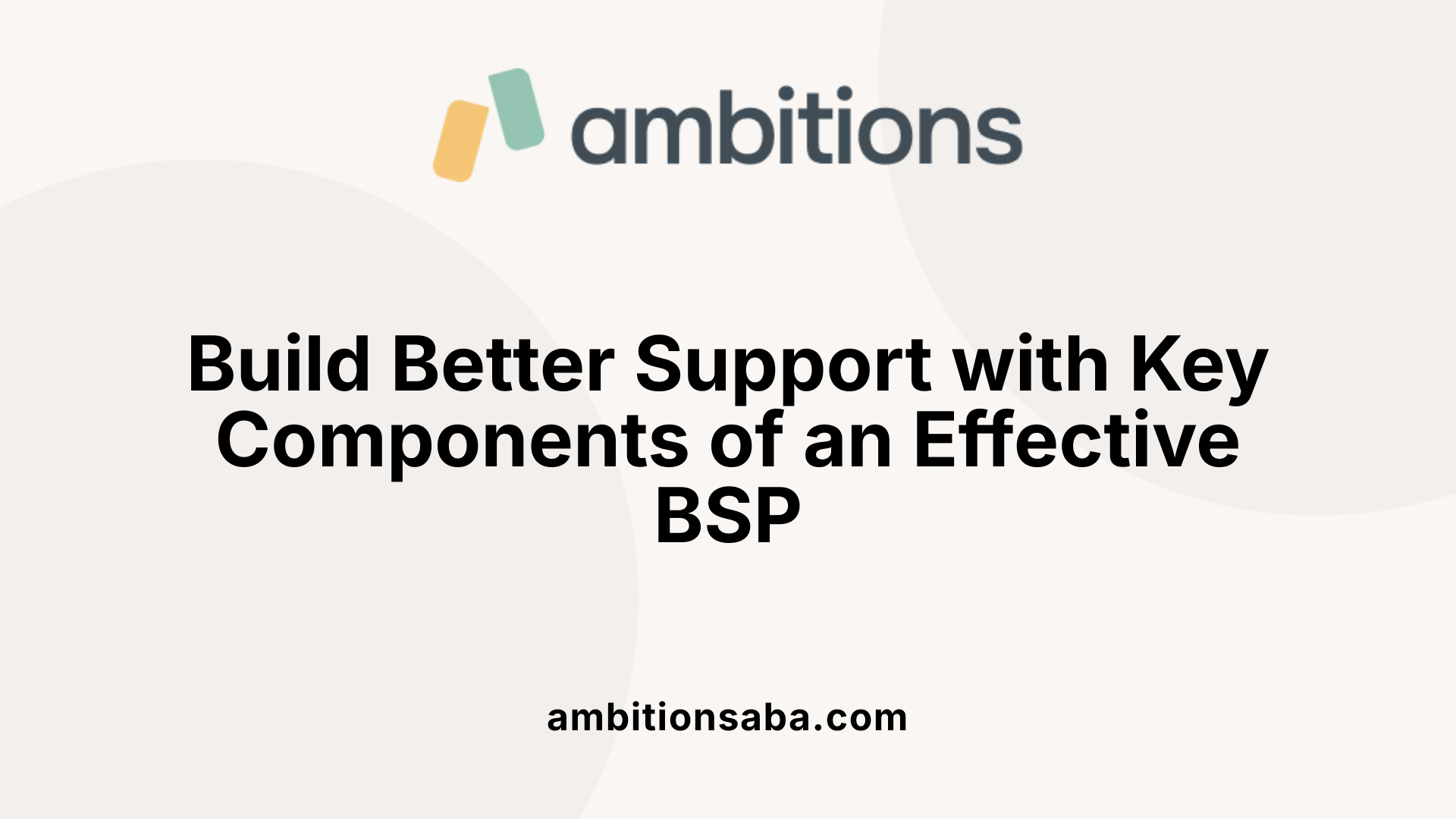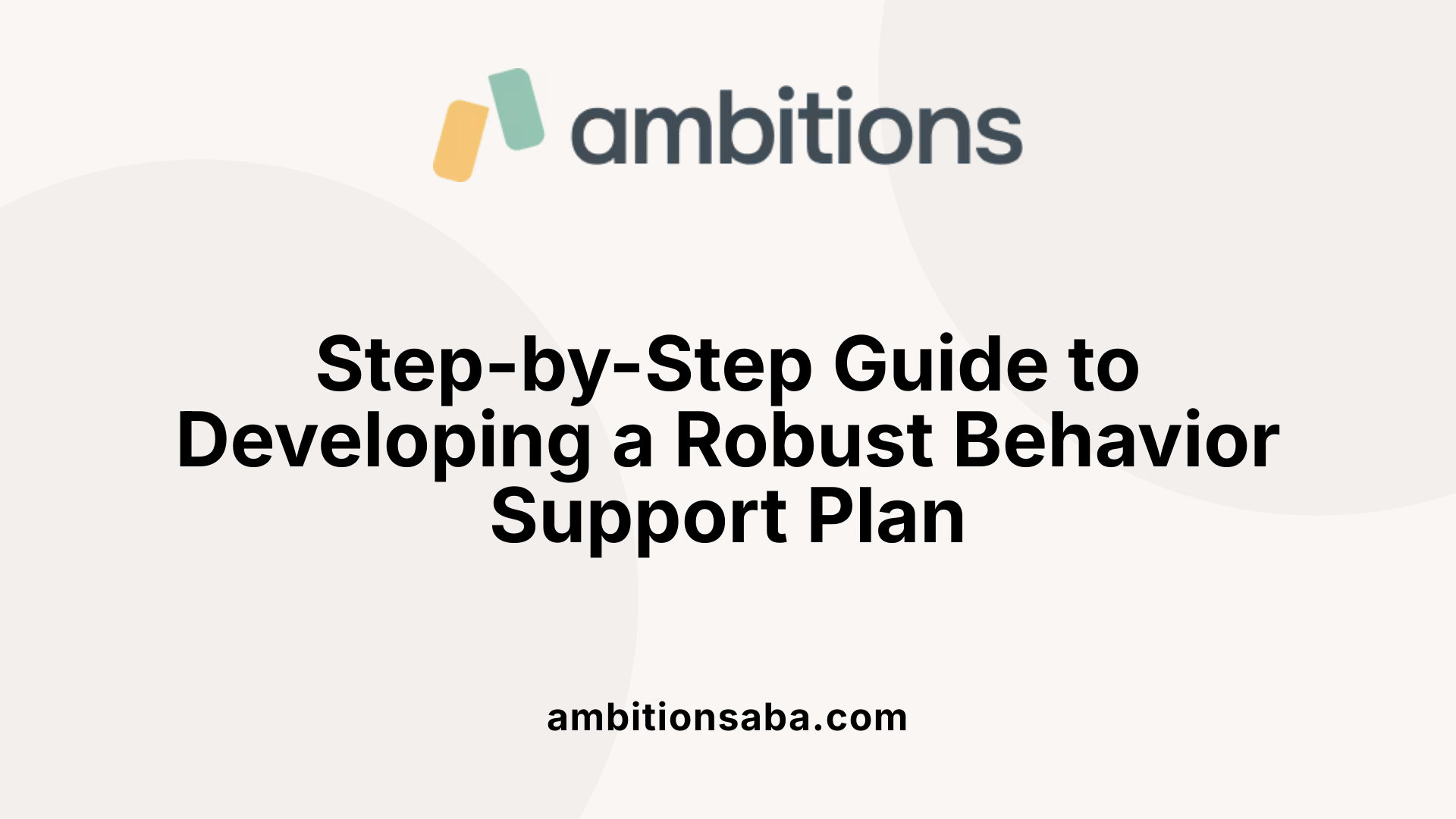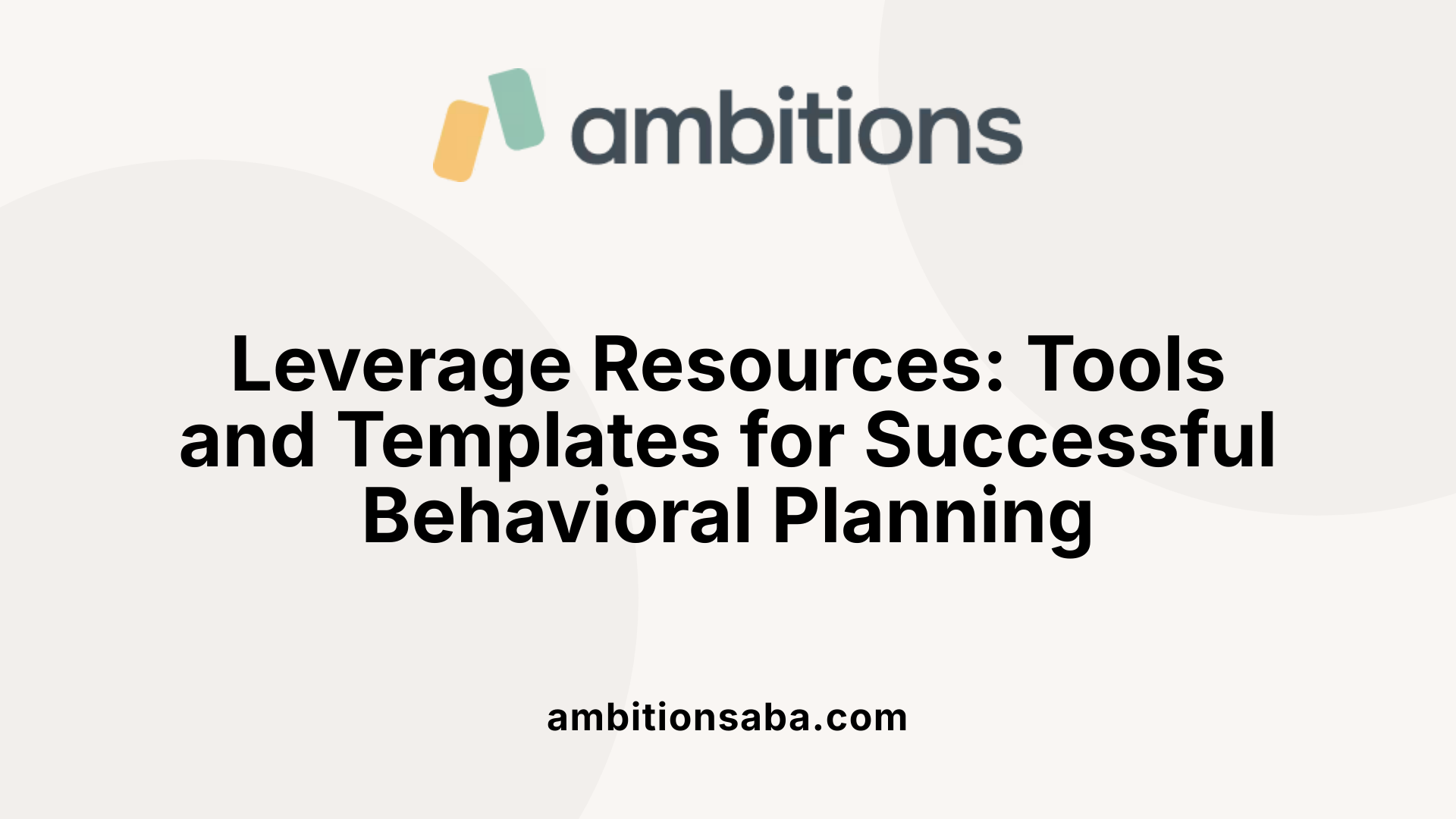Understanding the Foundations of Behavior Support Plans
Developing a behavior support plan (BSP) is a structured approach aimed at reducing challenging behaviors and promoting positive development. It involves a meticulous process rooted in thorough assessment, stakeholder collaboration, and evidence-based interventions. This article explores key stages and components vital for creating comprehensive and ethical behavior support plans that effectively address individual needs.
Conducting a Functional Behavior Assessment (FBA)

Why is an FBA important in developing behavior support plans?
A Functional Behavior Assessment (FBA) serves as the foundation for creating effective behavior support strategies. It helps identify the reasons behind a student's challenging behaviors, which is essential for designing interventions that are relevant and effective. Without understanding the function of a behavior, efforts to modify it may be ineffective or even counterproductive.
An FBA provides a detailed picture of what triggers problem behaviors, what consequences reinforce them, and the environmental context in which they occur. This information enables educators and support staff to develop targeted strategies that address the root causes rather than just the symptoms.
What methods are used to gather data during an FBA?
Collecting comprehensive, accurate data is critical in an FBA. Several methods are utilized, including:
- Observations: Direct watching of the student in natural settings to record behaviors as they occur, along with antecedents and consequences.
- Interviews: Talking with teachers, support staff, family members, and other individuals who observe the student regularly. This provides insights into patterns and triggers that may not be obvious during observations.
- Record Reviews: Analyzing existing data, such as incident reports, assessment records, and progress notes, to identify recurring behaviors and contextual factors.
These methods help build a well-rounded understanding of the behavior within its everyday environment.
How is data analyzed to hypothesize behavior functions?
Once data collection is complete, the next step is to analyze this information to formulate hypotheses about why the behavior occurs. This involves examining the antecedents, behaviors, and consequences documented during observations and interviews.
For example, if a student yells when asked to start a task and gains peer attention, the behavior may serve a social reinforcement function such as seeking attention.
The analysis typically follows the ABC model—Antecedent, Behavior, Consequence—which helps identify patterns and triggers. By pinpointing consistent antecedents and the reinforcers maintaining the behavior, practitioners can hypothesize whether the behavior is maintained by reasons such as gaining access to preferred items, escaping demands, sensory input, or seeking social interaction.
This hypothesized function guides the development of tailored interventions that address the underlying motivation, increasing the likelihood of lasting behavior change.
How can a comprehensive behavior support plan be developed?
Developing an effective behavior support plan begins with a thorough FBA. Start by gathering detailed data through observations, interviews, and record reviews to clearly define the target behavior in measurable terms.
Next, analyze the data to hypothesize the behavior's function—what maintains it and what triggers it. Based on these insights, select evidence-based strategies tailored to the identified function. These strategies include preventative (antecedent modifications), replacement behaviors that serve the same purpose, and reactive responses when the behavior occurs.
The plan should outline specific objectives, intervention steps, timelines, and methods to monitor progress. It is most effective when developed collaboratively with all stakeholders—teachers, support staff, families, and the individual—ensuring consistency in implementation.
Finally, the plan must be regularly reviewed and updated using ongoing data collection, adjusting strategies as needed to enhance effectiveness. This iterative process ensures the interventions remain relevant and responsive to the learner's changing needs.
More about FBA methods and best practices
For further insight into best practices and emerging methods in conducting FBAs, consulting recent literature and guidelines is recommended. The Wyoming Department of Health’s manual (2023) underscores the importance of systematic data collection, stakeholder involvement, and functional analysis in developing personalized interventions that support positive behavior change.
Identifying Components of an Effective BSP

What are the key components of an effective behavior support plan?
An effective Behavior Support Plan (BSP) hinges on several essential elements. It starts with defining the target behaviors clearly, providing operational descriptions that precisely state what the behavior looks like. This clarity ensures that everyone involved understands what behaviors are targeted and how they are measured.
Baseline data collected over a period—usually at least a month—serves as a foundation for understanding the behavior’s frequency, severity, and context. This data guides hypothesis formation about the behavior’s function, which is derived from a thorough Functional Behavioral Assessment (FBA). The FBA explores triggers, antecedents, consequences, and environmental factors that maintain the behavior.
From these hypotheses, the plan outlines individualized, evidence-based interventions. These include antecedent modifications aimed at preventing the behavior, teaching functionally equivalent replacement behaviors (FERBs), and reinforcement strategies to encourage desirable behaviors. Environmental modifications and proactive strategies are also integral to reducing problematic behaviors.
Clear, measurable goals are set for behavior reduction or skill acquisition. The plan specifies procedures for data collection, particularly ongoing monitoring to evaluate progress. This might involve recording frequency, duration, or latency of behaviors, depending on what is most appropriate.
Collaboration is crucial; the BSP must involve the individual, their guardians, and relevant professionals in the planning and decision-making process. Obtaining informed consent is essential, especially when planning the use of restrictive or intrusive interventions.
The plan also incorporates crisis management protocols to address behaviors that pose health or safety risks. It details escalation procedures, de-escalation techniques, and criteria for when to involve emergency responses.
Teaching strategies are articulated, including where, when, and how interventions will be implemented, along with staff responsibilities. Response procedures for behavioral errors are included to ensure consistency in responses.
Finally, the BSP emphasizes ongoing review and modification. Regular data analysis allows the team to assess effectiveness, make necessary adjustments, and ensure the plan remains relevant and effective over time.
This comprehensive approach ensures that interventions are tailored, systematic, and adaptable, leading to better support and improved outcomes for the individual.
Below is a summary table highlighting these components:
| Component | Description | Purpose |
|---|---|---|
| Behavioral Definitions | Clear, operational descriptions of target behaviors | Ensures consistent understanding and measurement |
| Baseline Data | Data on behavior frequency, severity, context | Guides hypothesis and planning |
| Functional Hypotheses | Informed guesses about triggers and functions | Guides targeted interventions |
| Interventions | Antecedent modifications, replacement behaviors, reinforcement | Reduce problematic behaviors, teach skills |
| Goals | Specific, measurable behavior outcomes | Track progress and success |
| Data Collection and Monitoring | Ongoing recording of behaviors | Evaluate effectiveness |
| Collaboration and Consent | Engagement of individual, families, professionals, informed consent | Ensure ethical, tailored support |
| Crisis Management | Strategies for safety, escalation guidelines | Address immediate safety concerns |
| Teaching and Response Strategies | Procedures for implementation and handling errors | Maintain consistency and clarity |
| Review and Adjustments | Periodic assessment and modification of plan | Sustain relevance and efficacy |
In essence, each element works together to create a structured, responsive, and adaptable framework that promotes behavioral change and supports the individual's development and safety.
Steps in Developing a Behavior Support Plan

What steps are involved in creating a behavior support plan?
Developing an effective Behavior Support Plan (BSP) involves several important stages that are critical for ensuring the plan is tailored to the individual's needs and effective in promoting positive behaviors.
The process begins with an assessment phase. This includes collecting comprehensive data to identify the person’s strengths, needs, and the underlying function of challenging behaviors. Typically, a Functional Behavior Assessment (FBA) is used, which involves observing the individual's behavior, conducting interviews, and reviewing relevant records. The goal is to determine what triggers the behavior, what functions it serves (such as seeking attention, avoiding tasks, or seeking comfort), and the environmental factors involved.
Once the assessment is complete, the next step is developing strategies that address the identified functions of behavior. These strategies can be proactive, such as environmental modifications and routine adjustments, to prevent triggers from occurring. Teaching strategies focus on introducing functional replacement behaviors that serve the same purpose as problematic behaviors but are more appropriate and socially acceptable.
Reinforcement systems are an essential part of the plan. These include positive reinforcement to encourage desired behaviors, tailored to leverage natural motivators and rewards suitable for the individual. Effective reinforcement can be delivered through individual or group systems, depending on the context.
Implementation is the stage where the strategies are put into action consistently. This requires clear communication among all team members, including teachers, support staff, family, and the individual, if appropriate. Consistency in responses to behaviors and clarity in communicating expectations are vital for the plan's success.
The final critical component is ongoing review and adjustment. Regular data collection—such as frequency, duration, or intensity of behaviors—helps evaluate whether the plan is working as intended. Based on this data, adjustments may include modifying strategies, reinforcement plans, or environmental factors. Changes are made collaboratively, ensuring the support plan remains relevant and effective as the individual's needs evolve.
Throughout this process, a person-centered approach is emphasized, involving individuals and their families in decision-making. Collaboration helps ensure that interventions are respectful of the individual's preferences and promote achievable, meaningful progress.
In summary, creating a behavioral support plan is a systematic process that begins with thorough assessment, followed by the development and implementation of targeted strategies, and concludes with ongoing evaluation and modification. This approach ensures the plan is individualized, effective, and adaptive to support positive behavior change.
Utilizing Tools, Templates, and Resources

Are there templates or tools available for creating behavioral intervention strategies?
Yes, a variety of templates and technological tools are accessible to assist in developing effective behavioral intervention strategies. These resources streamline the planning process, ensure consistency, and align interventions with evidence-based practices.
For instance, comprehensive templates provided by organizations like the Office of Superintendent of Public Instruction (OSPI) include sections for identifying behaviors, hypothesizing functions, and outlining specific intervention strategies. These templates are designed to facilitate the creation of Behavior Intervention Plans (BIPs) that are thorough, organized, and tailored to the individual’s needs.
In addition to paper templates, electronic tools such as Artemis ABA software enable practitioners to collect data, analyze behavior patterns, and monitor progress efficiently. Such digital platforms support real-time data entry, easy modifications, and visual data representation, which are crucial for ongoing plan adjustments.
Many of these templates and tools are publicly available online, often free or at low cost, and are crafted to meet the standards of best practices including functional behavior assessment (FBA). Their flexibility allows customization across different settings and populations—including children, youth, and adults with diverse needs.
How to adapt templates to individual needs
While templates provide a strong foundation, adapting them to the individual's unique behavioral patterns is essential for success. Start by thoroughly reviewing the collected data from assessments, observations, and interviews.
Modify sections such as:
- Behavior definitions: Make sure descriptions are specific and observable.
- Function hypotheses: Tailor explanations based on identified triggers and reinforcers.
- Intervention strategies: Customize proactive and reactive strategies sensitive to the individual's environment and preferences.
- Reinforcer selection: Use data to identify what truly motivates the individual.
Involving stakeholders—such as family members, educators, and support staff—in this customization process helps ensure that the plan is practical, acceptable, and sustainable.
Importance of staff training and stakeholder involvement
Effective implementation of behavioral plans depends heavily on well-trained staff and collaborative involvement. Staff should receive training on:
- How to interpret and utilize the plan components.
- Techniques for data collection and analysis.
- Strategies for consistent implementation of interventions.
- Crisis management procedures, if applicable.
Stakeholders, including family members and support team members, must be engaged through regular communication, training sessions, and review meetings. Their insights can guide modifications and enhance the plan's relevance.
Examples of comprehensive plans
A well-rounded behavioral plan covers all critical areas:
- Clear, operational definitions of target behaviors.
- Functional hypotheses explaining the purpose of behaviors.
- Prevention strategies focused on altering antecedents.
- Replacement behaviors that serve the same function.
- Consequence strategies to reinforce positive behaviors and reduce maladaptive ones.
- Crisis response procedures for safety risks.
- Ongoing data collection and progress review schedules.
These comprehensive documents serve as practical guides for staff and support teams, ensuring consistency and effectiveness in behavioral interventions.
| Resource Type | Description | Typical Features |
|---|---|---|
| Paper Templates | Downloadable forms for BIPs | Sections on behavior, hypotheses, interventions |
| Digital Tools | Software for data collection & plan management | Real-time data, visual analytics, customization |
| Training Modules | Staff training resources | Incident management, data handling, intervention techniques |
| Stakeholder Guides | Collaborative planning templates | Communication protocols, review checklists |
Using these tools and resources, professionals can craft tailored, effective behavior plans that support individuals in achieving meaningful behavior change, safety, and growth.
Monitoring, Review, and Compliance
How can behavior support plans be assessed and evaluated?
Behavior support plans (BSPs) require ongoing assessment to ensure they are effective and appropriately guiding behavior change. The primary method for evaluation involves continuous data collection, which includes tracking the frequency, duration, and intensity of targeted behaviors. This data provides a factual foundation to analyze whether interventions are working as intended.
Regular review sessions are essential. During these sessions, teams examine baseline data, progress notes, and behavior outcomes. These reviews help determine if the individual’s behaviors are decreasing or if positive replacement behaviors are increasing. Functional Behavioral Assessments (FBAs) play a critical role in this process by clarifying the functions of behaviors, guiding necessary adjustments, and ensuring interventions target the behavior's core causes.
Implementation fidelity — meaning how accurately staff adhere to the plan — also impacts evaluation. Monitoring whether staff consistently use reinforcement techniques, follow response strategies, and implement fading procedures is vital for accurate assessment.
Moreover, teams should strive to evaluate alternatives to restrictive interventions. Before resorting to more intrusive methods, less restrictive, evidence-based strategies should be prioritized, and their effectiveness carefully reviewed.
How often should reviews and data collection occur?
Reviews should be conducted at regular intervals, typically every 90 days, but more frequent checks may be necessary in response to urgent behavior issues or significant changes in the individual’s condition. Data collection should be ongoing, preferably daily or weekly, depending on the behavior's severity and frequency. Consistent data allows for timely adjustments to interventions, thereby increasing the likelihood of positive outcomes.
Who should be involved in the review process?
Effective review involves a collaborative team that includes educators, support staff, families, behavioral specialists, and the individual whenever possible. Family and guardian input is crucial for a comprehensive understanding of the individual’s needs and preferences. Regular stakeholder involvement ensures that the plan remains relevant, respectful of the individual’s rights, and aligned with personal goals.
How does compliance with regulatory standards fit into the evaluation process?
Plans must adhere to state and federal regulations, including established guidelines for restrictive practices. Documentation of progress, staff training, and any use of restrictive or aversive interventions should be meticulously maintained. Oversight by behavioral and human rights committees is mandated, especially if restrictive procedures are involved. These bodies review compliance with legal standards, ensuring that interventions are justified, proportionate, and reviewed periodically. This regulatory compliance not only safeguards the individual’s rights but also supports the plan’s overall integrity and effectiveness.
| Aspect | Frequency | Responsible Parties | Compliance Details |
|---|---|---|---|
| Data collection | Daily to weekly | Support staff, behavioral specialists | Ensure thorough, accurate, and timely data entry |
| Plan effectiveness review | Every 90 days, or as needed | Support team, family, specialists | Document progress, modify strategies accordingly |
| Staff training updates | Annually or when new procedures are introduced | Management, trainers | Confirm staff understanding and implementation fidelity |
| Oversight and regulation compliance | Continuous, with formal review at set intervals | Human rights and behavioral committees | Keep records of approvals, restrictions, and reviews |
Ultimately, diligent monitoring, consistent review, stakeholder engagement, and adherence to regulations are essential pillars to ensuring that behavior support plans are not only effective but also ethical and respectful of individual rights.
Best Practice Guidelines and Ethical Considerations
Involving stakeholders, including individuals and families
A fundamental aspect of developing effective behavior support plans is engaging all relevant stakeholders. This includes the individual receiving support, their family members, educators, support staff, and healthcare professionals. Person-centered planning promotes collaboration, ensuring that the plan reflects the individual’s preferences, needs, and cultural background. Active involvement of families and individuals helps build trust, improves adherence to interventions, and fosters a sense of ownership. Regular communication and shared decision-making are vital for tailoring strategies and updating the plan based on the individual’s evolving needs.
Legal and ethical standards in plan development
Developing a behavior support plan must adhere to applicable legal and ethical standards to protect the rights and dignity of the individual. These standards include compliance with federal and state laws such as the Americans with Disabilities Act (ADA) and relevant regulations outlined in the Rules of the Board of Regents and the Regulations of the Commissioner. Ethical considerations emphasize the importance of person-centered practices, informed consent, least restrictive interventions, and respect for individual autonomy. Plans should be based on comprehensive assessments, including functional behavioral assessments (FBA), which gather data from multiple sources to understand the underlying causes of behaviors.
Plans must integrate trauma-informed practices, ensuring that interventions do not retraumatize or stigmatize individuals. The use of restrictive or aversive measures is highly regulated and should only be employed when safety is at risk, following strict guidelines and obtaining proper consent. Maintaining confidentiality and ensuring transparency throughout the planning process uphold ethical standards.
Crisis management protocols and restrictive practices
Crisis management is a critical component within behavior support plans, especially for behaviors that pose health or safety risks. The plan should include clear crisis prevention strategies, early intervention procedures, and protocols for de-escalation. These protocols are designed to minimize the use of restrictive practices such as physical restraints, chemical restraints, or aversive procedures.
Restrictions and interventions should be used only as a last resort, with informed consent from the individual or their guardian. Any restrictive measures must be implemented by trained personnel and documented meticulously. Oversight by behavioral and human rights committees is mandatory to review the necessity, appropriateness, and safety of such practices.
Continuous staff training and resources for fidelity
Ensuring fidelity in implementing behavior support plans requires ongoing staff training and access to resources. All staff involved in executing the plan should receive comprehensive training on behavioral principles, data collection methods, intervention procedures, and crisis response protocols. Regular refresher courses and demonstration sessions help maintain high standards.
Resources such as manuals, visual aids, and decision-making tools support consistent application of strategies. Monitoring fidelity involves periodic observations and review of data to ensure plan implementation aligns with established procedures. Continuous professional development and consultation with behavioral specialists are vital for adapting strategies and improving outcomes based on ongoing data analysis.
Regulatory standards for behavior support plans
When developing support and intervention plans, adherence to regulatory standards is essential. Developers must follow relevant state and local regulations, such as those stated in the Rules of the Board of Regents and the Regulations of the Commissioner, ensuring compliance with federal and state laws. Plans must be rooted in thorough assessments, including functional behavioral assessments (FBA) that gather data from multiple sources, such as observations, interviews, and record reviews.
The behavioral intervention plan (BIP) should clearly specify support strategies aligned with the identified functions of behavior. Incorporating trauma-informed and positive behavioral support principles is crucial. Restrictive measures, like corporal punishment, should be avoided unless absolutely necessary and in accordance with strict safety guidelines. Regular review and modification of plans are necessary, with documentation shared with families, oversight committees, and relevant authorities. Quality standards, such as those outlined in the BSPARI (Behavior Support Plan and Review Initiative), help ensure practices are ethical, person-centered, and evidence-based.
By following these guidelines, practitioners ensure that behavior support plans are effective, respectful of individual rights, and compliant with legal requirements, fostering safer and more supportive environments for individuals with behavioral challenges.
Examples and Final Tips for Success
Where can I find examples of behavior support plans?
Looking at real-world examples of behavior support plans can greatly assist educators and support staff in developing their own effective strategies. Samples are available across various professional websites, educational resource platforms, and online repositories. These sources often feature detailed case studies and model plans tailored for different behavior challenges.
For instance, many websites provide multiple specific examples of Behavior Intervention Plans (BIPs) crafted for students who display behaviors like defiance, disrespect, or disruption. These plans are typically created through collaborative efforts among educational teams, ensuring they are individualized and based on comprehensive functional behavior assessments.
Most sample plans emphasize proactive, preventative, and positive strategies. They outline clear steps for modifying environments, teaching replacement skills, and using reinforcement to support desired behaviors. Many resources also include explanations about the development process, making it easier for educators and professionals to understand the structure and adapt plans to their own contexts.
How to Access These Resources
- Search with keywords like “examples of behavior support plans and case studies”
- Explore websites of educational agencies, state departments of education, or behavior support organizations
- Review repositories that host downloadable templates and real-case scenarios
Using these examples as a guide helps ensure your plans are thorough, practical, and aligned with best practices in behavioral support.
Final Remarks on Developing Effective Behavior Support Plans
Creating a well-structured and tailored behavior support plan requires a deep understanding of the individual's behavior, clear goals, stakeholder collaboration, and adherence to ethical standards. By conducting thorough assessments like the FBA, utilizing available templates and resources, and committing to ongoing review and adjustment, practitioners can develop effective strategies that promote positive behaviors and improve quality of life for individuals with challenging behaviors. Consistent training, documentation, and compliance with regulatory standards are essential to ensure that the interventions are safe, ethical, and effective.
References
- Behavior Intervention Plan (BIP): The Complete Guide to Writing a ...
- [PDF] Developing and Implementing a Positive Behavior Support Plan
- What Is a Behavior Intervention Plan? [PDF Template]
- 5 Steps to Writing a Behavior Support Plan - Simply Special Ed
- 5: Developing the Behavior Intervention Plan
- 3.16 – Behavior Support Strategies and Plans - Open Door Columbus
- Positive Behavior Support Plans - VCU Autism Center for Education
- Behavior Support Plan Requirements and Expectations



